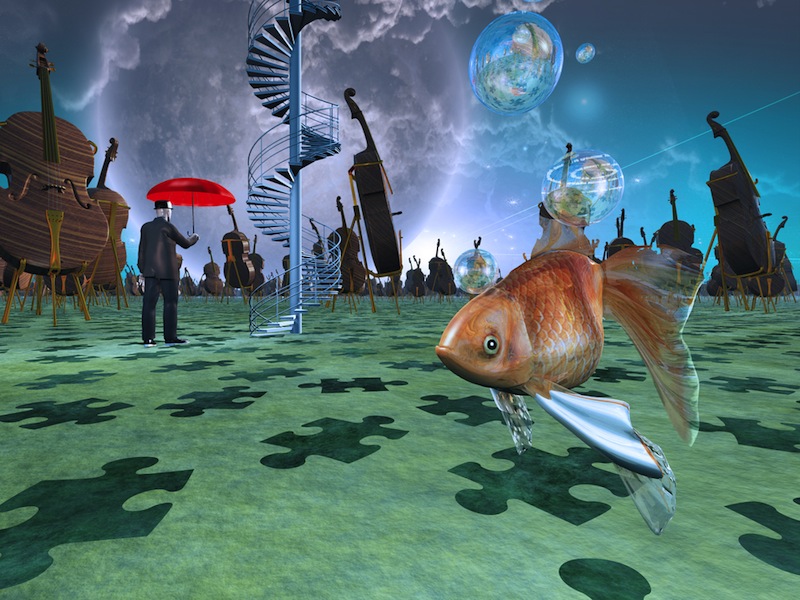Senses and Non-Sense: 7 Odd Hallucinations

The many documented cases of strange delusions and neurological syndromes can offer a window into how bizarre the brain can be.
It may seem that hallucinations are random images that appear to some individuals, or that delusions are thoughts that arise without purpose. However, in some cases, a specific brain pathway may create a particular image or delusion, and different people may experience the same hallucination.
In recent decades, with advances in brain science, researchers have started to unravel the causes of some of these conditions, while others have remained a mystery.
Here is a look at seven odd hallucinations, which show that anything is possible when the brain takes a break from reality.
1. Alice-in-Wonderland syndrome
This neurological syndrome is characterized by bizarre, distorted perceptions of time and space, similar to what Alice experienced in Lewis Carroll's "Alice's Adventures in Wonderland." [7 Mind-Bending Facts About Dreams]
Patients with Alice-in-Wonderland syndrome describe seeing objects or parts of their bodies as smaller or bigger than their actual sizes, or in an altered shape. These individuals may also perceive time differently.
Sign up for the Live Science daily newsletter now
Get the world’s most fascinating discoveries delivered straight to your inbox.
The rare syndrome seems to be caused by some viral infections, epilepsy, migraine headaches and brain tumors. Studies have also suggested that abnormal activity in parts of the visual cortex that handle information about the shape and size of objects might cause the hallucinations.
It's also been suggested that Carroll himself experienced the condition during migraine headaches and used them as inspiration for writing the tale of Alice's strange dream.
English psychiatrist John Todd first described the condition in an article published in the Canadian Medical Association Journal in 1955, and that's why the condition is also called Todd's syndrome. However, an earlier reference to the condition appears in a 1952 article by American neurologist Caro Lippman. The doctor describes a patient who reported feeling short and wide as she walked, and referenced "Alice's Adventures in Wonderland" to explain her body image illusions.
2. Walking Corpse Syndrome
This delusion, also called Cotard's Syndrome, is a rare mental illness in which patients believe they are dead, are dying or have lost their internal organs.
French neurologist Jules Cotard first described the condition in 1880, finding it in a woman who had depression and also symptoms of psychosis. The patient believed she didn't have a brain or intestines, and didn't need to eat. She died of starvation.
Other cases of Cotard's syndrome have been reported in people with a range of psychiatric and neurological problems, including schizophrenia, traumatic brain injury and multiple sclerosis.
In a recent case report of Cotard's syndrome, researchers described a previously healthy 73-year-old woman who went to the emergency room insisting that she was "going to die and going to hell." Eventually, doctors found the patient had bleeding in her brain due to a stroke. After she received treatment in the hospital, her delusion resolved within a week, according to the report published in January 2014 in the journal of Neuropsychiatry.
3. Charles Bonnet syndrome
People who have lost their sight may develop Charles Bonnet syndrome, which involves having vivid, complex visual hallucinations of things that aren't really there.
People with this syndrome usually hallucinate people's faces, cartoons, colored patterns and objects. It is thought the condition occurs because the brain's visual system is no longer receiving visual information from the eye or part of the retina, and begins making up its own images.
Charles Bonnet syndrome occurs in between 10 and 40 percent of older adults who have significant vision loss, according to studies.
4. Clinical lycanthropy
In this extremely rare psychiatric condition, patients believe they are turning into wolves or other animals. They may perceive their own bodies differently, and insist they are growing the fur, sharp teeth and claws of a wolf.
Cases have also been reported of people with delusional beliefs about turning into dogs, pigs, frogs and snakes.
The condition usually occurs in combination with another disorder, such as schizophrenia, bipolar disorder or severe depression, according to a review study published in the March issue of the journal History of Psychiatry in 2014.
5. Capgras delusion
Patients with Capgras delusion believe that an imposter has replaced a person they feel close to, such as a friend or spouse. The delusion has been reported in patients with schizophrenia, Alzheimer's disease, advanced Parkinson's disease, dementia and brain lesions.
One brain imaging study suggested the condition may involve reduced neural activity in the brain system that processes information about faces and emotional responses.
6. Othello syndrome
Named after Shakespeare's character, Othello syndrome involves a paranoid belief that the sufferer’s partner is cheating. People with this condition experience strong obsessive thoughts and may show aggression and violence.
In one recent case report, doctors described a 46-year-old married man in the African country Burkina Faso who had a stroke, which left him unable to communicate and paralyzed in half of his body. The patient gradually recovered from his paralysis and speaking problems, but developed a persistent delusional jealousy and aggression toward his wife, accusing her of cheating with an unidentified man.
7. Ekbom's syndrome
Patients with Ekbom's syndrome, also known as delusional parasitosis or delusional infestations, strongly believe they are infested with parasites that are crawling under their skin. Patients report sensations of itching and being bitten, and sometimes, in an effort to get rid of the pathogens, they may hurt themselves, which can result in wounds and actual infections.
It's unknown what causes these delusions, but studies have linked the condition with structural changes in the brain, and some patients have improved when treated with antipsychotic medications.
Email Bahar Gholipour. Follow us @LiveScience, Facebook & Google+. Original article on Live Science.










